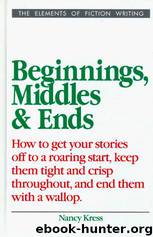Beginnings, Middles and Ends by Nancy Kress

Author:Nancy Kress [Kress, Nancy]
Language: eng
Format: epub
ISBN: 9780898799057
Publisher: Writer's Digest Books
Published: 1999-03-15T07:00:00+00:00
CHAPTER 7
SATISFYING ENDINGS: DELIVERING ON THE PROMISE
YOU'VE WRITTEN THE MIDDLE. Starting with the characters, conflict, and (sometimes) symbols you introduced so carefully in your opening, you went on to deepen our understanding of these through dramatized incidents in the middle. These incidents have shown us that your character is capable of change. The same incidents have made vivid the forces that will collide at your climax.
We can just feel these forces gathering. People are on the verge of being pushed into action, or disasters are on the edge of occurring, or secrets are about to be disclosed, or a deadline is almost here, or a situation has become so intolerable that it's obvious somebody is about to bring it toppling down around everybody else's ears. Whatever the specific events of your story, your middle has made it clear that things can't go on this way much longer. Something has to give.
Then a peaceful compromise is found and the story is over.
Huh?
Well, why not? Aren't compromises sometimes found in real life? Isn't everyone in favor of peaceful negotiation? And isn't it true that often people just have to live with bad situations indefinitely? Why can't a story end that way?
Because your story showed us forces in opposition to each other. Forces we expected to see collide in some way: quietly in a quiet story, noisily in a more dramatic one. But a collision of some sort we surely must have. You promised.
This is the clearest explanation of why some story endings work and others do not. At its beginning, a story makes the kind of implicit promise we've discussed throughout this book. In the middle, the development of both characters and conflict extends that promise by arranging forces in opposition to each other. We see, through skillfully chosen patterns of events, various problems and tensions come closer and closer to collision. Then comes the ending. It must use those same characters, conflicts, problems and tensions to show us the collision (the climax).
If the ending tries to use different characters (such as the cavalry riding over the hill at the last minute), the story will fail. If the ending tries to switch to some other last-minute conflict, the story will fail. If the ending tries to evade the promised collision (by, for instance, a peaceful compromise in which no one loses anything), the story will fail. You cannot, in other words, promise apples and deliver oranges. The middle of your story— how you've developed the implicit promise—determines your ending.
This isn't to say that there is only one possible ending for any story. There may be more than one. But the ending chosen must complete what has been promised, not violate it.
Let's look again at that favorite-because-so-well-known example, Gone With the Wind. The forces lined up here are Scarlett's obsession with Ashley, Rhett's love for Scarlett, Ashley's inability to either leave Melanie or kiss off Scarlett, the pressures exerted on the aristocratic South by the Civil War, and Scarlett's single-minded pursuit of money and security, even at the expense of "ladylike" behavior.
Download
This site does not store any files on its server. We only index and link to content provided by other sites. Please contact the content providers to delete copyright contents if any and email us, we'll remove relevant links or contents immediately.
Asking the Right Questions: A Guide to Critical Thinking by M. Neil Browne & Stuart M. Keeley(5649)
Autoboyography by Christina Lauren(5184)
Eat That Frog! by Brian Tracy(4436)
Dialogue by Robert McKee(4323)
Sticky Fingers by Joe Hagan(4103)
Journeys Out of the Body by Robert Monroe(3572)
Annapurna by Maurice Herzog(3424)
Full Circle by Michael Palin(3389)
Schaum's Quick Guide to Writing Great Short Stories by Margaret Lucke(3321)
Elements of Style 2017 by Richard De A'Morelli(3307)
The Art of Dramatic Writing: Its Basis in the Creative Interpretation of Human Motives by Egri Lajos(3017)
Atlas Obscura by Joshua Foer(2900)
The Diviners by Libba Bray(2887)
Why I Write by George Orwell(2877)
In Patagonia by Bruce Chatwin(2876)
The Fight by Norman Mailer(2848)
The Mental Game of Writing: How to Overcome Obstacles, Stay Creative and Productive, and Free Your Mind for Success by James Scott Bell(2845)
Venice by Jan Morris(2526)
The Elements of Style by William Strunk and E. B. White(2442)
